By Jackie Damrau, Editor
Books Reviewed in This Issue
The reviews provided here are those that are self-selected by the reviewers from a provided list of available titles over a specific date range. Want to become a book reviewer? Contact Dr. Jackie Damrau at jdamrau3@gmail.com for more information.
Equipping Technical Communicators for Social Justice Work: Theories, Methodologies, and Pedagogies
Rebecca Walton and Godwin Y. Agboka, eds.
Academic Writing Now: A Brief Guide for Busy Students, 2nd ed.
David Starkey
Everybody Eats: Communication and the Paths to Food Justice
Marianne LeGreco and Niesha Douglas
The Freelance Editor’s Handbook: A Complete Guide to Making Your Business Thrive
Suzy Bills, in consultation with Aaron Ostler
Profit Over Privacy: How Surveillance Advertising Conquered the Internet
Matthew Crain
A Library of Misremembered Books
Marina Luz
The Missing Readme: A Guide for the New Software Engineer
Chris Riccomini and Dmitriy Ryaboy
SEO for Everyone
Rebekah Baggs and Chris Corak
Baseline Shift: Untold Stories of Women in Graphic Design History
Briar Levit, ed.
Welcome to the Circular Economy: The Next Step in Sustainable Living
Claire Potter
Book Proposals That $ell: 21 Secrets to Speed Your Success, Revised ed.
Terry Whalin
The Missing Course: Everything They Never Taught You About College Teaching
David Gooblar
Planetary Health: Safeguarding Human Health and the Environment in the Anthropocene
Andy Haines and Howard Frumkin
UX Strategy: Product Strategy Techniques for Devising Innovative Digital Solutions, 2nd ed.
Jaime Levy
Listening to People: A Practical Guide to Interviewing, Participant Observation, Data Analysis, and Writing It All Up
Annette Lareau
How to Lead in Data Science
Jike Chong and Yue Cathy Chang
Voice Content and Usability
Preston So
Design Things That Make Sense: Tech. Innovator’s Guide
Deborah Nas
Influential Internal Communication: Streamline your corporate communication to drive efficiency and engagement
Jenni Field
Equipping Technical Communicators for Social Justice Work: Theories, Methodologies, and Pedagogies
Rebecca Walton and Godwin Y. Agboka, eds. 2021. Utah State University Press. [ISBN 978-1-64642-094-0. 256 pages, including index. US$31.95 (softcover).]
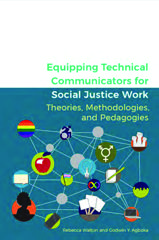 Equipping Technical Communicators for Social Justice Work: Theories, Methodologies, and Pedagogies argues for a “‘social justice turn’ in the field of TPC [technical and professional communication] in which the focus on critical analysis that informed the cultural turn of the 1990s extends into a focus on critical action” (p. 3). The book is an edited collection that includes twelve chapters and an afterword by various authors, chapters that cover distinct cases of theorizing, researching, and teaching social justice. For the editors, social justice research in TPC “investigates how communication, broadly defined, can amplify the agency of oppressed people” and “moves past description and exploration…to taking action to redress inequities” (p 3).
Equipping Technical Communicators for Social Justice Work: Theories, Methodologies, and Pedagogies argues for a “‘social justice turn’ in the field of TPC [technical and professional communication] in which the focus on critical analysis that informed the cultural turn of the 1990s extends into a focus on critical action” (p. 3). The book is an edited collection that includes twelve chapters and an afterword by various authors, chapters that cover distinct cases of theorizing, researching, and teaching social justice. For the editors, social justice research in TPC “investigates how communication, broadly defined, can amplify the agency of oppressed people” and “moves past description and exploration…to taking action to redress inequities” (p 3).
Each chapter of the collection explores a different communication situation, including its theoretical underpinnings, past scholarship on similar topics, and a new approach, such as a new method of doing research or a new way of teaching. For example, authors Emily Legg and Adam Strantz discuss a new approach to user experience (UX) design based on the Hawai’i missile false alarm, an approach that is “centered around the idea of local knowledges and local users as the necessary foundation of good design” (p. 61). Meanwhile, Oriana A. Gilson describes an “intersectional feminist rhetorical” approach to teaching technical communication that “prioritizes extraordinary users and marginalized perspectives” and “disrupts the non-expert/expert dichotomy” (p. 180).
Like all expert fields, the academic technical communication conversation has its own jargon, and the ongoing social justice turn of this conversation is no different. At the same time, authors are careful to define any pieces of jargon so that educated, non-specialist audiences could understand them. For instance, authors Laura Gonzales, Josephine Walwema, Natasha N. Jones, Han Yu, and Miriam F. Williams discuss the term “microaggressions,” a term that anyone versed in social justice terminology would be familiar with. They also define this term as “commonplace rhetoric and action—intentional and unintentional—that insults, harms, or otherwise adversely targets” marginalized community members (p. 15). This definition, coupled with narratives based on the authors’ own experiences, facilitates an understanding of the term so that the reader could identify, resist, and possibly intervene in microaggressions.
This is the book’s greatest strength: it does not so much present entirely novel approaches to social justice but presents novel approaches to enacting social justice within the academic field of technical communication. At the same time, with its emphasis on the redress of social inequality in such arenas as user experience design (p. 49), the law (p. 116), and the use of election technologies (p. 197), there’s an argument that the book does intend to influence industry practice. And this is supported by the explicit statement in the book’s Afterword where the editors argue for its application to “many work practices…from teaching to research to administrative work to industry practice” (p. 247).
If readers have a solid grounding in the academic technical communication conversation, then they will be excited by these novel approaches to researching and teaching, approaches that foreground the redress of social inequality. If the reader is an industry practitioner, I fear the use of academic jargon may make the book difficult to parse. Overall, Equipping Technical Communicators for Social Justice Work contains a much-needed discussion of grounded approaches to redressing social inequality within the realm of technical communication, and thus stands alone as possibly the only book ever to take on this topic.
Guiseppe Getto
Guiseppe Getto is a faculty member at East Carolina University. He is also President and Co-Founder of Content Garden, Inc., a content strategy and UX consulting firm.
Academic Writing Now: A Brief Guide for Busy Students
David Starkey. 2022. 2nd ed. Broadview Press. [ISBN 978-1-5548-1509-8. 230 pages, including index. US$39.09 (softcover).]
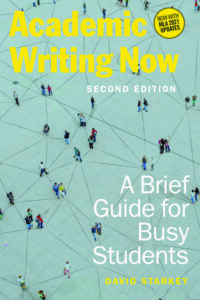 Comprehensive and authoritative while being friendly were my thoughts when I was reading Academic Writing Now: A Brief Guide for Busy Students. Especially useful is that this book covers the most recent versions of both American Psychological Association (APA, 7th edition) and Modern Languages Association (MLA, 9th edition) style. Seeing the examples of student essays in both APA and MLA style should prove useful to both students and teachers.
Comprehensive and authoritative while being friendly were my thoughts when I was reading Academic Writing Now: A Brief Guide for Busy Students. Especially useful is that this book covers the most recent versions of both American Psychological Association (APA, 7th edition) and Modern Languages Association (MLA, 9th edition) style. Seeing the examples of student essays in both APA and MLA style should prove useful to both students and teachers.
Academic Writing Now covers the expected topics of essay writing including high school versus university writing, how to organize an essay, what to write about, and the basics of logos, ethos, and pathos (p. 62). Of course, this book covers how to write a good introduction, body paragraph, and conclusion (plus transitions); how to deal with graphics, research, editing, and revising; and frequent errors. Each chapter includes class discussions ideas and follow up work for individuals and groups.
Of note is a statement about what university professors really want to see in their students’ writing. Based on “talking to colleagues, holding workshops, and collecting written responses to a questionnaire,” Starkey concludes that his “fellow professors wanted students to (1) be clear, (2) address their audience, and (3) stay on task” (p. 30).
Also, of note is Starkey’s handling of pronoun usage. In this second edition of Academic Writing Now, “when the gender of the referent is unclear, a singular noun will receive a plural pronoun” (p. 15). Concerning the rationale for pronoun use, Starkey refers to a 2019 New York Times opinion piece (“It’s Time for ‘They.’”) written by Farhad Manjoo. Manjoo states, “we should use ‘they’ more freely, because language should not default to the gender binary” (p. 15).
Jeanette Evans
Jeanette Evans is an STC Associate Fellow; active in the Ohio STC community, currently serving on the newsletter committee; and co-author of an Intercom column on emerging technologies in education. She holds an MS in technical communication management from Mercer University and undergraduate degree in education.
Everybody Eats: Communication and the Paths to Food Justice
Marianne LeGreco and Niesha Douglas. 2021. University of California Press. [978-0-520-31424-5. 342 pages, including index. US$29.99 (softcover).]
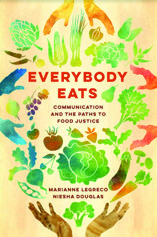 Food is essential. However, the food systems that Americans depend on aren’t available to everyone equally, resulting in food insecurity and hunger. In Everybody Eats: Communication and the Paths to Food Justice, authors Marianne LeGreco and Niesha Douglas focus on projects designed to reduce food insecurity in the Greensboro, North Carolina community. The authors establish four communication areas essential to any community organization project: engaging communities, mobilizing resources, documenting processes, and sustaining conversations. Each case study focuses on these four elements of communication that are essential to any social equity project.
Food is essential. However, the food systems that Americans depend on aren’t available to everyone equally, resulting in food insecurity and hunger. In Everybody Eats: Communication and the Paths to Food Justice, authors Marianne LeGreco and Niesha Douglas focus on projects designed to reduce food insecurity in the Greensboro, North Carolina community. The authors establish four communication areas essential to any community organization project: engaging communities, mobilizing resources, documenting processes, and sustaining conversations. Each case study focuses on these four elements of communication that are essential to any social equity project.
Greensboro has a history of diversity and social change. The Warnersville area of downtown Greensboro was dedicated in 1865 as a space for newly freed slaves to purchase land and create a community. In the 1960s, Greensboro gained national attention for lunch counter sit-ins. The authors are both scholars and activists, and while their words anchor the book in research and theory, they also let the community members speak. In fact, the second chapter in the book devotes several pages to a table that meticulously lists the “cast of voices” that drive the food justice initiatives the authors discuss. LeGreco and Douglas also remind readers that the community isn’t a monolith. Residents and other project stakeholders have disparate concerns and interests. Communication is necessary to understand these diverse needs.
Two principal elements of communication are stories and data. In Chapter 7, the Ethnosh program was developed to promote local immigrant-owned restaurants. This chapter stresses the importance of storytelling and photography. And while it’s crucial to listen to community members’ stories, data is also important. For two projects, the Warnersville Community Food Task Force and the Kitchen Connects GSO, it was essential to understand the story the data told. For the Warnersville Community Food Task Force, data about food-related diseases like diabetes and heart disease helped identify a need. Research before and during the Kitchen Connects GSO, a food business incubator program, kept the project organizers informed about who was—and was not—using the program, so they could ensure that it was meeting the community’s needs.
The Greensboro area serves as an appropriate context for food justice initiatives. In 2015, the area ranked #1 in food hardship in the United States by the Food Research and Action Center (FRAC). That year, 28.2% of area residents experienced food hardship. During the years in which the projects in the book took place, the area’s ranking fell, and in 2018, 19.2% of residents experienced food hardship, earning the area a ranking of #14. But not every case study in the book is a success story. Chapter 10 describes the Renaissance Community Co-op, an unsuccessful project that provides lessons about sustaining conversations and making sure everyone involved understands the community’s needs and expectations and the initiative’s goal. Each chapter ends with a section dedicated to lessons learned and recommendations for applying the authors’ research to broader social equity projects, not just those relating to food justice.
Elizabeth Hardin
Elizabeth Hardin is an STC member and a lecturer in the English department at the University of Alabama in Huntsville, where she teaches technical and business writing. She has a master’s degree in English and a bachelor’s in Computer Science.
The Freelance Editor’s Handbook: A Complete Guide to Making Your Business Thrive
Suzy Bills, in consultation with Aaron Ostler. 2021. University of California Press. [ISBN 978-0-520-38133-9. 326 pages, including index. US$24.95 (softcover).]
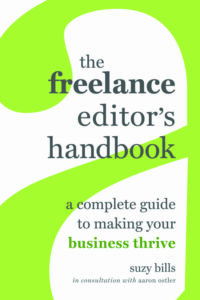 Suzy Bills has written a handy compendium on the business side of editorial freelancing aimed at editors who are considering freelancing or are new freelancers. Although much of her information should be familiar to established freelancers, the depth of information and its organization should prove invaluable to newbies.
Suzy Bills has written a handy compendium on the business side of editorial freelancing aimed at editors who are considering freelancing or are new freelancers. Although much of her information should be familiar to established freelancers, the depth of information and its organization should prove invaluable to newbies.
It makes sense to read Bills’ ideas sequentially, since they fall into the order a freelance editor would normally follow: making the big decision to freelance, setting up your business, creating your overall strategy, finding clients and marketing, building your website and using LinkedIn, pricing your services, writing contracts and invoices, managing your time, finding a balance between life and work, planning for taxation, and managing your finances.
Bills constantly frames her advice as strategies. For example, the table on page 57 shows a sample business plan containing “business standards” that might help some editors maintain their sanity:
- Work between 9:00 a.m. and 5:30 p.m. on weekdays; no work on weekends.
- Charge at least $60 per hour.
- Charge 50 percent of payment in advance.
- Charge a fee for rush requests.
- Edit in Word only.
For new freelancers, one especially valuable set of useful strategies touches on the cold email (today’s “cold call”) you send to a prospective client. Another one concerns how to set your rates. And don’t skip the section on writing your LinkedIn profile. The author’s details are always many and deep. On all topics she supplies emotional considerations, how-to steps, warnings, statistics, and a number of supplemental resources to pursue.
One caution for international readers is that the discussion is U.S.-based. The chapter on taxes, for example, provides only legal details relevant to U.S. editors, including things to look out for while filling out certain Federal forms.
Because Bills devotes the entire book to the business of freelance editing, I might move “Business” out of the subtitle and retitle the book something like The Freelance Editor’s Business Handbook or The Complete Guide to Making Your Freelance Editing Business Thrive.
Much of the material can be found in various Web pages, books, and articles, but Bills has organized it into an easy-to-use compendium. This book offers the fullest treatment that I’ve seen of the business side of freelance editing. With its wealth of detail, her book deserves a place on the same shelf as other University of California Press publications on editing, including Amy Einsohn and Marilyn Schwartz’ wonderful The Copyeditor’s Handbook (4th ed. 2019).
Avon J. Murphy
Avon J. Murphy is an STC Fellow who serves the Society as a researcher and as editor of the annual Summit Proceedings. A onetime college professor and government writer, he is a technical editing contractor and the principal in Murphy Editing and Writing Services, based in western Washington.
Profit Over Privacy: How Surveillance Advertising Conquered the Internet
Matthew Crain. 2021. University of Minnesota Press. [ISBN 1-5179-0505-7. 206 pages, including index. US$25.00 (softcover).]
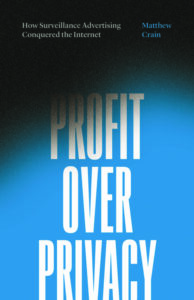 At a time when the reputation of surveillance capitalism has grown so toxic that credible demands are being made to break up the big technology companies, it would be good to have a clearer idea of how we managed to get into this mess.
At a time when the reputation of surveillance capitalism has grown so toxic that credible demands are being made to break up the big technology companies, it would be good to have a clearer idea of how we managed to get into this mess.
Now comes Matthew Crain to give the practice a more systemic, historically grounded origin story. In Profit Over Privacy: How Surveillance Advertising Conquered the Internet, he shows that the invasive, privacy violating, personal-data-vacuuming web we have today is the culmination of decades of political and technical economic engineering.
Brilliantly researched and thoroughly documented, the book argues that surveillance capitalism could not have existed outside of politics.
As Crain tells it, needing a way to boost a sagging economy, a Clinton administration dominated by neoliberal free market thinking sought to privatize and commercialize the internet as quickly as possible. The negotiations that followed sidelined privacy and civil society concerns and gave the private sector a green light to build the “information superhighway” as it saw fit.
Crain does a superb job of tracing the details, but briefly, the marketing complex—marketers, advertisers, publishers—embarked on a rough and tumble scramble to build a commercial internet based on targeted advertising. Fueled by an avalanche of venture capital and ad spending by dot-com startups vying to get big fast, what started with banner ads and tracking cookies, soon grew into a full-on surveillance arms race. The marketing complex found ways to create user profiles, first from online data, then from offline records. Google added search-term and browser history tracking. The social networks added personal profile and social connection tracking. Mobile added GPS location tracking.
Crain also chronicles how Big Tech fended off pro-privacy efforts both from developers and from privacy and civil society interests.
Free of regulatory restraint, what had started as an effort to sell stuff soon morphed into a pervasive surveillance operation based on collecting personally identifiable information that could also be used for other purposes: social and economic sorting and targeting, determining who would be offered or denied opportunities, abetting government and private surveillance, and creating endless opportunities for social and political mischief.
Crain argues that decades of political decisions and neoliberal governance led us to our present crisis, and that it is long past time for a new political vision for the internet, one that “includes greater democratic accountability, more equitable distribution of power, and far less subservience to the demands of the market” (p. 147).
Anyone interested in crafting a response to surveillance capitalism that avoids the mistakes of the past will find much of value in Profit Over Privacy.
Patrick Lufkin
Patrick Lufkin is an STC Fellow with experience in computer documentation, newsletter production, and public relations. He reads widely in science, history, and current affairs, as well as on writing and editing. He chairs the Gordon Scholarship for technical communication and co-chairs the Northern California technical communication competition.
A Library of Misremembered Books
Marina Luz. 2021. Chronicle Books. [ISBN 978-1-4521-7159-3. 96 pages. US$12.95 (hardcover).]
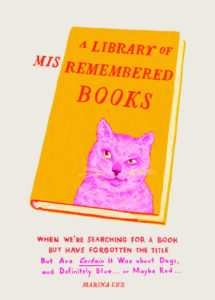 Have you ever tried to describe a book you’ve read but can’t quite remember the title, the author, or even the book premise? You resorted to describing the cover and even used the vast internet to see if you could share your memory fragments so someone else could provide the missing details. If so, you may have provided Marina Luz with her inspiration for A Library of Misremembered Books, a book of art depicting book covers as described by readers that can’t quite remember them.
Have you ever tried to describe a book you’ve read but can’t quite remember the title, the author, or even the book premise? You resorted to describing the cover and even used the vast internet to see if you could share your memory fragments so someone else could provide the missing details. If so, you may have provided Marina Luz with her inspiration for A Library of Misremembered Books, a book of art depicting book covers as described by readers that can’t quite remember them.
Each page offers an imagined book cover organized into sections of popular book genres such as science fiction, horror, children’s, etc. My favorite section is the last one titled “Ummm…” which contains book covers that are so hilariously vague there’s no way of knowing what the actual book genre would be. My favorite cover depicted in this section is of a marquee that reads, “Inspiring true story” (p. 89).
The book’s premise is unique and fun, but I did find myself disappointed because the book is small like a pocketbook. This isn’t the type of book you want to carry with you; rather, it’s more likely this book would sit on your coffee table. I believe a full-sized book with full-page illustrations would better serve this purpose.
With that small note aside, I enjoyed A Library of Misremembered Books. This book is a celebration of books and art. As the back of the book puts it, “…this book is a tribute to the indelible impression that books leave on our hearts and souls—if not always on our memories.”
Sara Buchanan
Sara Buchanan is an STC member and a content strategist at LCS in Cincinnati, OH. In her free time, she’s an avid reader, enjoys cooking, and doting on her cats: Buffy and Spike.
The Missing Readme: A Guide for the New Software Engineer
Chris Riccomini and Dmitriy Ryaboy. No Starch Press. 2021. [978-1-7185-0183-6. 264 pages, including index. US$24.99 (softcover).]
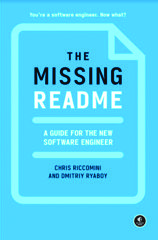 The Missing Readme: A Guide for the New Software Engineer by Chris Riccomini and Dmitriy Ryaboy is aimed at new software engineering graduates starting their careers. The authors cover technical and interpersonal skills needed to succeed.
The Missing Readme: A Guide for the New Software Engineer by Chris Riccomini and Dmitriy Ryaboy is aimed at new software engineering graduates starting their careers. The authors cover technical and interpersonal skills needed to succeed.
The book’s structure is easy to follow: each chapter is divided into clear sections punctuated with effective bulleted and numbered lists. Callouts provide real world examples of the scenarios under discussion. Finally, each chapter ends with a concise table of Dos and Don’ts as well as references for additional reading on the chapter’s topic. The authors encourage you to jump around as needed.
The first two chapters outline the journey from beginner to competent engineer. You should familiarize yourself with your organization’s structure and processes as well as gain competence by reading existing documentation and code, shadowing more experienced workers, and learning by doing small tasks with limited risk to the larger project (pp. 2–25).
The next few chapters are code-centric, but some principles apply to technical communication and other fields, as professionals often work with pre-existing products or documentation. Specifically, you should not “go rogue” and ignore your organization’s standards just because you disagree with them; changes to standards must go through department processes to ensure everyone is on board and disruption is limited (p. 41). You should also leave code (or documentation) cleaner than you found it but avoid massive rewrites without department buy-in (p. 42). Dedicated chapters for a technical audience go into detail on best practices for integrating diagnostics, managing dependencies, testing, doing code reviews, and deploying to production.
After in-depth chapters on best practices for writing code, the authors introduce larger organizational practices for technical design, creating evolvable architectures, and Agile development. In any design process, the first step is to have stakeholders identify the problem at hand and prioritize. Always ask “What happens if we don’t solve this problem?” and determine if that outcome is acceptable; not every problem needs to be solved (p. 174). To ensure your system architecture stays resilient over time as more demands are made on the product, don’t add things you don’t need yet. Prematurely adding code you think you might need later only complicates the product and requires additional maintenance and testing (p. 195). The chapter on Agile development is a high-level overview and introduces the basics on sprint planning, stand-ups, and retrospectives (p. 218).
Finally, the authors cover working with your manager to communicate effectively and guide your career in the right direction. Check in frequently (ideally weekly or bi-weekly) one-on-one to ask questions about the organization’s direction, to solicit career feedback and advice, and to develop a relationship (p. 234). Check in with your manager long before you feel you should be put up for a promotion so you can address any skills gaps beforehand (p. 254).
The Missing Readme is a practical handbook for someone new to software development. I would recommend it to programmers and programming managers as an introduction to industry terminology, processes, and coding practices.
Bonnie J. Shamp Winstel
Bonnie J. Shamp Winstel is the Assistant Manager of Software Development for Book Systems, Inc. in Huntsville, Alabama. She received her master’s degree in English and Technical Communication at the University of Alabama-Huntsville in May 2013.
SEO for Everyone
Rebekah Baggs and Chris Corak. 2021. A Book Apart. [ISBN 978-1-952616-07-5. 180 pages, including index. US$24.00 (softcover).]
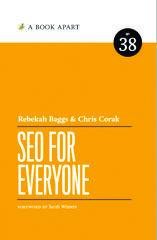 SEO for Everyone is a thorough overview of modern search engine optimization (SEO) practices written for a design and user experience (UX)-oriented audience. While I remain unconvinced by the eyebrow-raising claim on the inside cover that this is the “first” book to teach readers “how to optimize content for real-world users, not just algorithms,” SEO for Everyone does go beyond a mere overview of SEO concepts and highlights helpful strategies for eliciting stakeholder buy-in and cross-departmental collaboration.
SEO for Everyone is a thorough overview of modern search engine optimization (SEO) practices written for a design and user experience (UX)-oriented audience. While I remain unconvinced by the eyebrow-raising claim on the inside cover that this is the “first” book to teach readers “how to optimize content for real-world users, not just algorithms,” SEO for Everyone does go beyond a mere overview of SEO concepts and highlights helpful strategies for eliciting stakeholder buy-in and cross-departmental collaboration.
Rebekah Baggs and Chris Corak, cofounders of the content strategy and design consultancy ONWARD, insist on a “human-centered” approach to SEO. In practice, this means bringing search intent research into the content design process. SEO for Everyone can be a dense read, given the characteristic brevity of its publisher. The authors pack the pages with useful information about which industry-standard tools to use and which specific metrics to keep your eye on to best monitor your site’s organic search performance. It also features instructive screenshots, especially for illuminating important topics that could be unfamiliar to its design-oriented audience, such as what Schema.org structured data markup in JSON-LD format ought to look like.
The fourth chapter, “SEO in Design and Content,” provides innovative insights worth reading. This chapter explains how to bring “equal parts content, design, and SEO” (p. 96) together to plan content around business goals and user tasks extrapolated from themes of search intent. The authors even include a handy template that practitioners can use to map out everything they’ll need to craft a successful web page.
The fifth chapter, “SEO in Development,” is an admirable introduction to technical SEO, which includes aspects such as metadata, crawling and indexing, redirects, XML sitemaps, and mobile responsiveness. The chapter does not go deep enough into any tool to serve as an exhaustive guidebook for practicing technical SEO, but it introduces the reader to all the aspects of which they need to be cognizant.
SEO for Everyone is very much a book of its time. The tools and resources the authors recommend are indeed the current industry standards but given the ever-changing nature of the practice (and the inscrutable whims of Google), this might not be the case for long. Acknowledging this, the book concludes with a note about how algorithms and tools will inevitably change, but a “human-centered” approach is timeless. This means that you ought to read this right away if you are interested; and you should be, since a solid understanding of SEO metrics is how web content professionals can add persuasive, quantitative heft behind their recommendations.
Josh Anderson
Josh Anderson, CPTC, is an Associate Information Architect at Precision Content. Josh was an English teacher in Japan and an SEO Specialist in the Chicagoland area before earning a Master of Information at the University of Toronto.
Baseline Shift: Untold Stories of Women in Graphic Design History
Briar Levit, ed. 2021. Princeton Architectural Press. [ISBN 978-1-64896-006-2. 192 pages, including index. US$27.50 (softcover).]
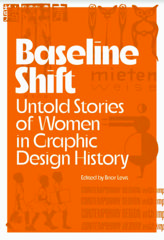 The development of a historical narrative for the graphic design profession is still very new, and like any other young history, it has its problems. The collection of essays presented in Baseline Shift: Untold Stories of Women in Graphic Design History works to remedy the problems created by those who told the initial story of graphic design’s history. Edited by Briar Levit, a professor at Portland State University and director of the renown documentary film Graphic Means, Baseline Shift contains 15 essays that have the potential to transform the narrative approach for histories of graphic design.
The development of a historical narrative for the graphic design profession is still very new, and like any other young history, it has its problems. The collection of essays presented in Baseline Shift: Untold Stories of Women in Graphic Design History works to remedy the problems created by those who told the initial story of graphic design’s history. Edited by Briar Levit, a professor at Portland State University and director of the renown documentary film Graphic Means, Baseline Shift contains 15 essays that have the potential to transform the narrative approach for histories of graphic design.
The telling of graphic design history has been dominated by a narrative that favors the design hero, who is an individual designer tolling away by himself, and solving design’s greatest problems. The use of the male pronoun in this statement might lead the reader to believe that this author is relying on the male default, but this is intentional to show the male bias in graphic design history. In fact, many historians and practitioners have noted that the current narrative in histories of graphic design is predominantly White and male. And while researchers have been working to expand this narrative to be more inclusive of the stories of women, minorities, as well as other stories that have been left out of this history, Baseline Shift takes a unique approach that will inform future telling’s of graphic design history.
The material is fresh, the average reader is unlikely to have heard of any of the women or collectives presented in this book. What readers will recognize is the named institutions, such as the Bauhaus or Monotype, not the women themselves. Even those actively engaged in researching graphic design history might recognize a handful of the women at best. Baseline Shift takes a feminist approach to the telling of graphic design histories, featuring specific named female designers, collectives, and what could be considered history’s unsung heroes. One example of the “unsung hero” is the inclusion of women from the type drawing department at Monotype; type drawing is not a sexy part of design history but the redrawing and resizing of type was a very essential part of type production. It is just one example of how the design hero approach is a patriarchal way of telling history and one that has ignored women’s roles.
The contents are inclusive, not only featuring stories from Indigenous designer Angel De Cora and Black designer Louise E. Jefferson but also histories that intersect with Black, Indigenous, and People of Color (BIPOC) history, such as the Madam Binh Graphics Collective. The Afterword is provided by Martha Scotford, an influential feminist design historian who is mentioned in several essays for her call to historians to expand the telling of graphic design history to be more inclusive to women and their roles, however much in the background they might fall. Baseline Shift is a quick read, which could easily be devoured by an interested reader in one sitting; however, it deserves to be read slowly and thoughtfully.
Amanda Horton
Amanda Horton holds an MFA in Design and currently teaches graduate and undergraduate courses at the University of Central Oklahoma (UCO) in the areas of design history, theory, and criticism. She is also the director of the Design History Minor at UCO.
Welcome to the Circular Economy: The Next Step in Sustainable Living
Claire Potter. 2021. Lawrence King Publishing. [ISBN 978-1-91394-712-5. 192 pages. US$19.00 (hardcover).
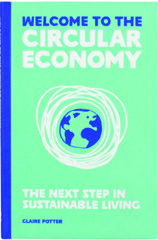 Claire Potter owns what she calls a circular economy design studio. With this award-winning studio located in Brighton, United Kingdom, and her design work, Potter helps to save CO2 and create value from waste material as she explains at https://onecircular.world/, which is one of her projects. She notes that she thinks globally and works locally. This project provides steps a person can take to bring circularity into the world. Welcome to the Circular Economy: The next step in sustainable living explains in a friendly, creative way how to be part of a circular economy.
Claire Potter owns what she calls a circular economy design studio. With this award-winning studio located in Brighton, United Kingdom, and her design work, Potter helps to save CO2 and create value from waste material as she explains at https://onecircular.world/, which is one of her projects. She notes that she thinks globally and works locally. This project provides steps a person can take to bring circularity into the world. Welcome to the Circular Economy: The next step in sustainable living explains in a friendly, creative way how to be part of a circular economy.
Potter explains on her web site that,
“The circular economy is a regenerative system of living, working and interacting with the world using a series of overlapping themes. Many of them you will recognise–and many of them you will already be doing. And why is this important? It is critical that we work together to combat climate change, dwindling resources and the pollution of our lands and seas. We need to address global inequalities and we need to do it urgently. A circular economy helps us to create a better world. The good news? Creating a circular economy takes all of us, and many individual actions are very simple to fit into our lives.”
Potter explains in Welcome to the Circular Economy that people need to adhere to the ideas of refuse – reduce – reuse – repair – refill – retail – rent – redirect – recycle – resources – regenerate – regulate – restructure. She devotes a chapter to each idea. In each chapter, Potter expresses her ideas in a way where I could relate. In the Rent chapter, for example, she mentions the idea of “just in case” (p. 83), which is a term Potter mentions as it relates to hoarding. This is something I understand all too well as it has to do with keeping things we might not need. It also has to do with excess. Potter makes a case for renting instead of owning as with an example she provides of renting a radio as people often did at one time. Renting means saving resources and eliminating waste (p. 89).
We could use her ideas in our professional and personal lives and make the world a better place. This is what I would want.
Jeanette Evans
Jeanette Evans is an STC Associate Fellow; active in the Ohio STC community, currently serving on the newsletter committee; and co-author of an Intercom column on emerging technologies in education. She holds an MS in Technical Communication Management from Mercer University and undergraduate degree in Education.
Book Proposals That $ell: 21 Secrets to Speed Your Success
W. Terry Whalin. 2022. Revised ed. Morgan James Publishing. [ISBN 978-1-63195-510-5. 164 pages. US$16.95 (softcover).]
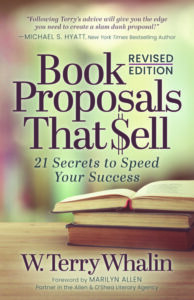 I’m willing to bet that you have a great book idea but little understanding of how to turn it into a New York Times best seller. Or you may have a half-finished manuscript sitting in your desk drawer, and you don’t know what to do with it. Well, your fortunes have changed, because you now have access to Terry Whalin’s excellent advice on how to craft and market your book in Book Proposals That $ell: 21 Secrets to Speed Your Success.
I’m willing to bet that you have a great book idea but little understanding of how to turn it into a New York Times best seller. Or you may have a half-finished manuscript sitting in your desk drawer, and you don’t know what to do with it. Well, your fortunes have changed, because you now have access to Terry Whalin’s excellent advice on how to craft and market your book in Book Proposals That $ell: 21 Secrets to Speed Your Success.
- Terry Whalin has a wealth of experience to draw upon as best-selling author and current acquisition editor at Morgan James Publishing. He provides us with an insider’s guide to the workings of a publishing house where he discusses the economics of the publishing industry and confronts us with the truth that unsolicited manuscripts are the last ones that an editor reads. That’s why it’s so important to craft a proposal that succinctly and successfully markets your writing. And although the book focuses on non-fiction writing, you can apply most of the advice to fiction work as well.
Book Proposals That $ell starts with what we as technical writers might consider to be obvious—research your audience, know the marketplace, and never trust spellcheck—but it’s the nuances of preparing a proposal that make this a valuable book for aspiring as well as experienced writers. With clarity and warmth, Whalin takes you step by step through the long litany of required stages needed to develop an insightful idea into an inviting proposal.
From topic development to market analysis to authorship (including the pitfalls of being too attached to your work) to final synopsis, Whalin takes you on a virtual verbal tour of how the publishing world operates. His personable presentation style leads to the feeling that you are on a friendly walk and talk with him through the publishers’ offices; exploring the detailed ins and outs of how things work around here and what you need to create a proposal that will get the office buzzing.
One sobering point Whalin makes noticeably clear is this: “Hey, this is going to be a lot of work!” (p 98). But he doesn’t stop with the 21 secrets to authoring a successful book proposal. The last fifth of the book contains one appendix after another loaded with information and insights that would make an excellent primer in and of themselves. I especially appreciated the thorough example provided on page 128 of Appendix D on the “Thomas Nelson Guide to Writing a Winning Book Proposal.”
Every bookstore has a section full of “How To Get a Book Published” resources available. I would have to put Terry Whalin’s Book Proposals That $ell at the top of the list as a must read for writers who are serious about getting published.
Lynne Cooke
Lynne Cooke is a Clinical Assistant Professor at Arizona State University where she teaches courses on usability, digital media, and portfolio development. She is also a member of the Arizona Chapter of STC and the Internship Coordinator at ASU.
The Missing Course: Everything They Never Taught You About College Teaching
David Gooblar. 2019. Harvard University Press. [ISBN 978-0-674-26038-2. 272 pages, including index. US$22.95 (softcover).]
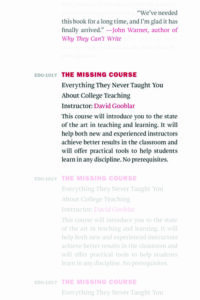 Although teaching is a major part of any academic’s job, graduate students are trained to do research and receive little, if any, instruction in how to teach. Most are left to muddle through by imitating how they were taught, mostly by standing in front of the class lecturing. A growing amount of research in pedagogy now shows that lecturing to passive students does little to help them learn, and recommends a more engaging, active, student-centered approach. Although this is well known to education theorists, it gets applied in too few classrooms.
Although teaching is a major part of any academic’s job, graduate students are trained to do research and receive little, if any, instruction in how to teach. Most are left to muddle through by imitating how they were taught, mostly by standing in front of the class lecturing. A growing amount of research in pedagogy now shows that lecturing to passive students does little to help them learn, and recommends a more engaging, active, student-centered approach. Although this is well known to education theorists, it gets applied in too few classrooms.
With The Missing Course: Everything They Never Taught You about College Teaching, David Gooblar hopes to change that. Gooblar teaches English and Gender Studies at the University of Iowa and writes the “Pedagogy Unbound” column for the Chronicle of Higher Education.
Drawing on his classroom experience, on his extensive reading in the available research, and on ideas he received from other teachers, Gooblar argues that teaching is not just about covering material, but about helping students revise themselves, learn new skills, and re-evaluate how they view the world.
Much of The Missing Course is devoted to giving practical strategies for creating an optimum learning environment, one in which students feel that they own the course, are eager to participate, and are fully engaged in their own learning adventure. Toward that end, Gooblar emphasizes the importance of “teaching the students in the room” (p. 106). Students do not arrive as blank slates but as persons with prior experience, attitudes, and preconceptions, and it is important to discover where the students currently are to guide them. Gooblar discusses various strategies for keeping abreast of the students, including using surveys and short informal essays as diagnostics.
Throughout the book, the reader will find state-of-the art suggestions for handling the full range of situations the instructor must face, from course planning, to setting expectations, to creating a nurturing classroom experience, to handling evaluation and assessment, to understanding and handling student cheating, to mentoring and conducting office hours, and working with different types of learners. Gooblar also addresses the difficulties of teaching in tumultuous times, and of preparing students to deal with current realities such as “fake news.”
In the education environment, it is not just the students who must learn and change. Gooblar recommends that teachers continually revise their own teaching. He offers many suggestions for improving your teaching, including making the most of student evaluations, and sitting in on other teacher’s courses to see how others are doing things.
While Gooblar clearly explains the reasoning behind his suggestions, his emphasis is always on practical applicable actions. Although centered in his experience teaching rhetoric and writing, many of his insights and strategies should be adaptable to any discipline.
Whether you are a new teacher just starting out, or an experienced teacher looking to up your game, The Missing Course would be well worth your while.
Patrick Lufkin
Patrick Lufkin is an STC Fellow with experience in computer documentation, newsletter production, and public relations. He reads widely in science, history, and current affairs, as well as on writing and editing. He chairs the Gordon Scholarship for technical communication and co-chairs the Northern California technical communication competition.
Planetary Health: Safeguarding Human Health and the Environment in the Anthropocene
Andy Haines and Howard Frumkin. 2021. Cambridge University Press. [ISBN 978-1-108-72926-0. 440 pages, including index. $US24.99 (softcover).]
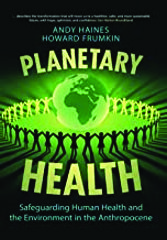 In Planetary Health: Safeguarding Human Health and the Environment in the Anthropocene, Andy Haines and Howard Frumkin aim to address a gap in environmental literature by explaining how environmental changes affect human health. In short, this book “aspires to provide a compelling overview of how human activities impact on natural systems, and the implications of the resulting changes for health, well-being, and even survival both today and in the foreseeable future” (p. xii). Published at a time that they call a “critical juncture,” the book is intended for “early pioneers and to a new generation of informed and open-minded scientists, practitioners, policymakers, and increasingly the wider public” (p. xii), with the overall purpose of guiding these readers toward necessary environmental and health transitions. Haines and Frumkin are active environmental and public health scientists who have held previous and present positions on the Intergovernmental Panel on Climate Change, the Rockefeller Foundation-Lancet Commission on Planetary Health, and the National Centers for Environmental Health at the Centers for Disease Control and Prevention.
In Planetary Health: Safeguarding Human Health and the Environment in the Anthropocene, Andy Haines and Howard Frumkin aim to address a gap in environmental literature by explaining how environmental changes affect human health. In short, this book “aspires to provide a compelling overview of how human activities impact on natural systems, and the implications of the resulting changes for health, well-being, and even survival both today and in the foreseeable future” (p. xii). Published at a time that they call a “critical juncture,” the book is intended for “early pioneers and to a new generation of informed and open-minded scientists, practitioners, policymakers, and increasingly the wider public” (p. xii), with the overall purpose of guiding these readers toward necessary environmental and health transitions. Haines and Frumkin are active environmental and public health scientists who have held previous and present positions on the Intergovernmental Panel on Climate Change, the Rockefeller Foundation-Lancet Commission on Planetary Health, and the National Centers for Environmental Health at the Centers for Disease Control and Prevention.
From the start, Haines and Frumkin explain how human health is not simply a biomedical matter but is intricately connected to the environment and Earth’s natural systems. There are 12 extensively researched and accessible chapters that cover the human impact on the environment, climate change, pollution, vulnerability and risks, adaptation and resilience, information and disinformation, energy, urban health, food systems and land use, the role of health professionals, and sustaining planetary health moving forward. The chapters cover historical perspectives on each topic, how we got where we are, environmental and health implications of continuing the present path, and in many chapters, ways toward recovery and sustainability when possible, and adaptability where we have already gone too far.
Since the subject matter is science related, there are numerous graphics that illustrate technical information and, for the most part, they are helpful and easy to understand. There are only a few instances where they did not work well (Table 4.2, which was almost unreadable). But mostly, I found the graphics complementary and illustrative so that even someone without a technical background could make sense of the overly complex topics and detailed information provided in each chapter. The chapters are well organized and informative, taking readers by the hand to understand the intricate web of environmental matters and how they directly affect human health. However, the subject matter is still highly technical, and the reading can be taxing because the authors are thorough and the chapters comprehensive. Thus, there is some hesitation in me agreeing that Planetary Health is a book for the wider public, but it is an incredibly detailed resource for graduate students and scholars researching environmental and/or public health in the Anthropocene.
Diane Martinez
Diane Martinez is an associate professor of English at Western Carolina University where she teaches technical and professional writing. She previously worked as a technical writer in engineering, an online writing instructor, and an online writing center specialist. She has been with STC since 2005.
UX Strategy: Product Strategy Techniques for Devising Innovative Digital Solutions
Jaime Levy. 2021. 2nd ed. O’Reilly Media. [ISBN 978-1-492-05243-2. 302 pages, including index. US$44.99 (softcover).]
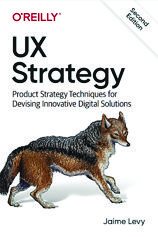 One of the least understood terms in the user experience (UX) world is the meaning of “UX strategy” which has changed remarkably over the years, as Jaime Levy notes. Today, she argues, the term is synonymous with product strategy, a term that describes “who your customers are, how your product fits into the current market, and how it will achieve business goals” (p. 6). This is the central crux that the book takes on, that UX is about understanding the business model behind a product or service and how users will interact with this business model as customers. They do so, Levy says, by approaching a product or service with a particular mental model in mind.
One of the least understood terms in the user experience (UX) world is the meaning of “UX strategy” which has changed remarkably over the years, as Jaime Levy notes. Today, she argues, the term is synonymous with product strategy, a term that describes “who your customers are, how your product fits into the current market, and how it will achieve business goals” (p. 6). This is the central crux that the book takes on, that UX is about understanding the business model behind a product or service and how users will interact with this business model as customers. They do so, Levy says, by approaching a product or service with a particular mental model in mind.
Besides other UX strategy models that focus solely on design, Levy argues for a model that considers four tenets: business strategy, value innovation, validated user research, and frictionless UX (p. 12). The business behind a product or service must have a means of bringing that product or service to market. This means must provide new value to customers that they can’t find elsewhere. User research then must validate this value. And user research must then result in a user experience that provides that value seamlessly.
Levy then uses the rest of UX Strategy: Product Strategy Techniques for Devising Innovative Digital Solutions, Chapters 3–10, to provide models and practices for enacting this framework. Each chapter (Chapter 6: Storyboarding Value Innovation, p. 145) is centered thematically on an approach to moving a design project through her framework. And in each chapter, she provides specific techniques (identify clear features, take advantage of UX influencers, perform a feature comparison, and storyboard value innovation, pp. 150-164) for enacting that chapter’s approach. Levy ends each chapter with a high-level recap that gives clear takeaways (don’t waste time on a product that hasn’t been validated with customers, p. 193). Reading UX Strategy from start to finish, one encounters a complete process for enacting her take on UX strategy.
This process focuses on the practices of defining the initial value proposition (Chapter 3), conducting competitive research (Chapter 4), analyzing the competition (Chapter 5), storyboarding value innovation (Chapter 6), creating prototypes for experiments (Chapter 7), conducting online user research (Chapter 8), and designing for conversion (Chapter 9). Levy’s last chapter is a concluding chapter that reflects on her experiences with product creation. Though these individual practices are not new to UX, Levy’s specific approach to them is.
Having done a fair amount of research into the world of UX, this reviewer can attest that this framework is entirely novel and not represented elsewhere in the literature, though I have increasingly encountered this notion of melding business and UX goals within the past five years or so. Readers will find within the pages of UX Strategy a complete workflow for enacting UX strategy, which is a valuable thing to find and something that is unique within the literature of this field.
Guiseppe Getto
Guiseppe Getto is a faculty member at East Carolina University. He is also President and Co-Founder of Content Garden, Inc., a digital marketing and UX consulting firm.
Listening to People: A Practical Guide to Interviewing, Participant Observation, Data Analysis, and Writing It All Up
Annette Lareau. 2021. The University of Chicago Press. [ISBN 978-0-224-80643-3. 326 pages, including index. US$20.00 (softcover).]
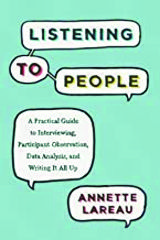 Annette Lareau’s Listening to People: A Practical Guide to Interviewing, Participant Observation, Data Analysis, and Writing It All Up is an excellent guidebook to two important techniques for qualitative research: interviews and participant observations (ethnography).
Annette Lareau’s Listening to People: A Practical Guide to Interviewing, Participant Observation, Data Analysis, and Writing It All Up is an excellent guidebook to two important techniques for qualitative research: interviews and participant observations (ethnography).
Lareau is primarily writing for graduate students (and undergraduates) who are going to do a months-long study. If this applies to you, you need this book. If you are an instructor who is mentoring students doing a qualitative research project, this would be a great book to recommend. As Lareau says, this is the “realistic and practical” book she wished she had when starting out (p. 2).
For those of us already in the profession, Lareau’s book is equally valuable. She takes us through the entire process from “dreaming and thinking” (Chapter 1) to preparing, getting ready to go into the field, collecting the data, writing good notes, analyzing, and writing clearly.
As a technical communicator and usability specialist, you’ll appreciate Lareau’s conversational style. She writes directly to us with “I” and “you.” This is a book of solid advice by an academic; but it’s not in a formal, academic style.
Listening to People is a very reassuring book. Lareau knows that projects don’t always go smoothly. She acknowledges, “Adjustment and change are integral to the process of interviewing and participant observation” (p. 5). She writes about the flexibility you need when doing field research and helps us understand the glitches that can happen and how to deal with them.
Lareau’s field is social science. Her own research is about class, race, ethnicity, and parental choice. So, you may have to reinterpret the specifics of her advice and examples for your own field research. But there is still much to glean from what she says.
For example, because of her research topics, Lareau has had to confront internal biases and issues of inclusion—important points for any researcher. As she writes: “In doing a study, your own identity matters because conducting research raises complex questions about the authority and legitimacy of researchers to convey the lives of others” (p. 27). And she goes on to explore these issues that researchers are becoming more aware of and attuned to now than they were years ago.
Another notable feature of Listening to People is the way that Lareau shares examples from her own and others’ projects, including both failures and successes. She gives us transcripts of parts of interviews and observations, with detailed annotations, explaining why a particular choice of question or follow-up was wise or not wise. This is great mentoring in a book.
If you do any field research, you’ll find Listening to People helpful: supporting much that you already know, empathizing with the frustrations you may have, and giving you good ideas for dealing with the realities of qualitative research.
Janice (Ginny) Redish
Ginny Redish helps clients and colleagues meet business goals and users’ needs through content strategy and plain language. Her book, Letting Go of the Words–Writing Web Content that Works, (Elsevier, 2nd ed., 2012) still gets rave reviews. Ginny is an STC Fellow and winner of several STC awards.
How to Lead in Data Science
Jike Chong and Yue Cathy Chang. 2021. Manning Publications Co. [ISBN 978-1-61729-889-9. 514 pages, including index. US$59.99 (softcover).]
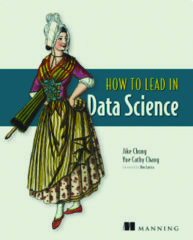 Many recent advancements in our world are data science (DS) applications in industry/academia. In healthcare, genomics/virus research relies on vast databases to make life saving vaccines for public health. Handheld devices may soon transform the way healthcare operates by transmitting real-time data. In the field of artificial intelligence, the neural net is only as effective as the “learning” it does with data input to “teach” it how to conduct its task. These applications support the relevance of How to Lead in Data Science to create, organize, and manage leadership in the field. For this reason, it is a needed resource for an expanding industry.
Many recent advancements in our world are data science (DS) applications in industry/academia. In healthcare, genomics/virus research relies on vast databases to make life saving vaccines for public health. Handheld devices may soon transform the way healthcare operates by transmitting real-time data. In the field of artificial intelligence, the neural net is only as effective as the “learning” it does with data input to “teach” it how to conduct its task. These applications support the relevance of How to Lead in Data Science to create, organize, and manage leadership in the field. For this reason, it is a needed resource for an expanding industry.
Jike Chong and Yue Cathy Chang state that they authored this book for data scientists. Lay readers may have difficulty with the book yet are encouraged to scan through it as it can serve as a generic management guide. This book describes concepts that are universal to other technical fields, which makes it useful across all industries besides the growing DS field. “The contribution of DS to the economy is still in its infancy as of 2021. According to LinkedIn Talent Solutions data, the discipline has found the most traction in IT, computer software, and internet industries” (p. 412). Growth in the data scientist field is occurring in financial services, banking, insurance, health care, biotech, pharmaceuticals, and fitness, and is likely to increase quickly due to delays in current product pipelines. “The scarcity of data product manager talent is a significant bottleneck for companies looking to develop data and intelligence-driven products and features” (p. 454).
The initial chapters introduce real-life data scientists at varying levels of their career development. Each scientist is analyzed according to their positive performance and areas of needed growth. The authors tie these examples to detailed graphs of the progressive levels of data science advancement. The book uses the TEE-ERA fan (Technology, Execution, Expert Knowledge, Ethics, Rigor, Attitude) in Figure 2.1 of Chapter 2, which also appears on the inside of the back cover. The authors refer to these capabilities and virtues at all levels of the data scientist’s development from a strong technical lead to a manager to a director and, finally, to arrive at the executive level of performance. (The authors also outline a second career track as the path of an individual data scientist outside of management.)
Although How to Lead in Data Science emphasizes that technical knowledge and expertise are foundational to DS, these are the bare minimum skills for survival. The authors sprinkle advice throughout the book with tips for thriving in the field with the most important being to select an industry you like and will grow to love. Only with this affinity can you develop proper relationships with others, remain positive, keep current on technical advances, and keep a relevant skill set for influencing and inspiring an industry. The bottom line is to prove that data can bring impact and success in data science through this detailed guide. Who could go wrong!
Julie Kinyoun
Julie Kinyoun is an on-call chemistry instructor at various community colleges in Southern California. An avid reader, she enjoys reviewing books that help her become a better educator.
Voice Content and Usability
Preston So. 2021. A Book Apart. [ISBN 978-1-952616-01-3. 132 pages, including index. US$24.00 (softcover).]
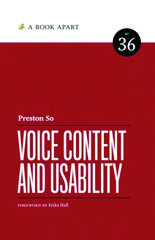 A Book Apart books are quite different from other books: always lean, simple, and to the point. Rather than focus on a broad topic like “usability,” they drill down into a specific sub-topic with laser-like clarity. Such is the case with Voice Content and Usability by Preston So, a 132-page volume that zeroes in on a little understood topic in user experience (UX): voice content and how to make it usable. Though So admits voice content is an outlier in the wide range of communication channels available to today’s users, it is growing in importance. “Voice content is an outlier, but it’s a thrilling one,” he says in the introduction. “Now is a great time to immerse yourself in it . . . you’ll end up readier than ever for the future . . .” (p. 3).
A Book Apart books are quite different from other books: always lean, simple, and to the point. Rather than focus on a broad topic like “usability,” they drill down into a specific sub-topic with laser-like clarity. Such is the case with Voice Content and Usability by Preston So, a 132-page volume that zeroes in on a little understood topic in user experience (UX): voice content and how to make it usable. Though So admits voice content is an outlier in the wide range of communication channels available to today’s users, it is growing in importance. “Voice content is an outlier, but it’s a thrilling one,” he says in the introduction. “Now is a great time to immerse yourself in it . . . you’ll end up readier than ever for the future . . .” (p. 3).
So then proceeds to lay out in six chapters many of the essential elements of voice UX, namely what it is (Chapter 1), how to develop content for it (Chapter 2), how to craft dialogues (Chapter 3), how to diagram user flows (Chapter 4), how to ready voice content for launch (Chapter 5), and what the future holds for voice content (Chapter 6). Each chapter includes heuristics and examples that lay out the chapter’s topic in terms even beginners can understand clearly. This includes brief stories about the applications of voice interfaces in the real world.
This process begins in Chapter 1 when So explains why we interact with voice interfaces, which he says is because we “need something done,” “want to know something,” or “want someone to talk to” (p. 5). He then explores several types of voice interactions, including transactional and informational (pp. 6–8) as well as devices that depend on voice content, such as interactive voice response (IVR) systems, screen readers, and voice assistants (pp. 8–12). He closes this chapter with a description of voice content itself, which he simply defines as “content delivered through voice” (p. 13). He also defines key benchmarks for effective voice content, namely legibility and discoverability (pp. 14–21).
There aren’t many books on voice content and UX concerns, so it’s difficult to judge this book against its small field of counterparts, but this reviewer found it to be incredibly accessible, conversational, and easy to engage with. Having read it, I have a much better understanding on the place voice content plays in communication and what benchmarks it needs to hit to be usable for the wide range of users who engage with it daily. And I think other readers will find within the pages of Voice Content and Usability a welcome diversion into a fascinating topic that is delivered exceptionally well.
Guiseppe Getto
Guiseppe Getto is a faculty member at East Carolina University. He is also President and Co-Founder of Content Garden, Inc., a digital marketing and UX consulting firm.
Design Things That Make Sense: Tech. Innovator’s Guide
Deborah Nas. 2021. BIS Publishers. [ISBN 978-90-6369-614-6. 176 pages. US$19.99 (softcover).]
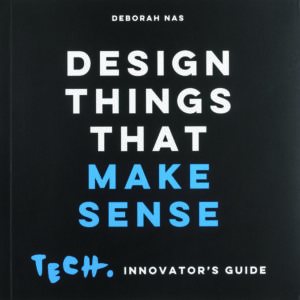 Deborah Nas’s Design Things That Make Sense: Tech. Innovator’s Guide offers a straightforward method for balancing the engineer’s fascination with technology with the consumer’s expectation of practical usability. Nas’s book is particularly timely given the increasing interconnectivity of technologies and usability options of contemporary products. Cars, for example, are no longer just machines, but “AI-powered, networked, self-driving computers on wheels” available through a variety of “new business models” that allow customers to buy a car directly, share it with others, or buy a “car subscription,” all within a “mobility as a service” model (p. 14). For Nas, a “product” includes all aspects associated with the creation, sale, and use of an item or service, and must be designed within that context to achieve “user-centered innovation” (p. 4).
Deborah Nas’s Design Things That Make Sense: Tech. Innovator’s Guide offers a straightforward method for balancing the engineer’s fascination with technology with the consumer’s expectation of practical usability. Nas’s book is particularly timely given the increasing interconnectivity of technologies and usability options of contemporary products. Cars, for example, are no longer just machines, but “AI-powered, networked, self-driving computers on wheels” available through a variety of “new business models” that allow customers to buy a car directly, share it with others, or buy a “car subscription,” all within a “mobility as a service” model (p. 14). For Nas, a “product” includes all aspects associated with the creation, sale, and use of an item or service, and must be designed within that context to achieve “user-centered innovation” (p. 4).
Products make sense for consumers if they are easy to understand, fulfil their needs, and address fears about new technologies; for the company, if they fit the firm’s purpose, brand, marketing strategy, and create financial value; for the designer, if they involve developing innovative technology. Products achieve this goal if they simultaneously increase benefits and reduce resistance to their usage.
Nas’s book offers twenty-four practices for strengthening product benefits, and thirteen for neutralizing consumer resistance. Benefits include offering greater consumer control over the product, ensuring a “transparent” user-interface (pp. 120–121), and—given that “80% of a product’s usage is due to only 20% of its features” (p. 43)—employing a “Keep It Simple Stupid” (KISS) criterion (p. 44). Adding unused features ensures consumer resistance, so focusing on human-centered design is critical. Fifty percent of start-ups fail because they do not meet “customer needs” (p. 20). Among “consumer hardware startups,” the rate is 97% (p. 20)—so designing for usability is imperative.
Making products—especially “new-to-the-world products” that have no real precedent (p. 24)—intuitively easy to use satisfies practical consumer expectation and mitigates psychological fear of newness. The NEST thermostat integrates the simplicity of turning a dial with internal and hence “invisible” electronics that adjust temperature automatically to changing conditions, such as whether anyone is home (pp. 152–153). This solution overcomes resistance and increases product benefits by implementing the “Most Advanced Yet Acceptable” design principle (p. 150). It replicates the simplicity of a previous “popular and user-friendly Honeywell thermostat” (p. 153) while making advanced technology unobtrusively available to the consumer. The NEST thermostat integrates the benefits of saving money, simplicity, personalization, customization, anytime/anywhere application, and increased efficiency, all while overcoming consumer resistance to the unfamiliar (p. 153).
The design of Nas’s book follows its own advice by presenting design concepts as practices, parameters, and sets of dos and don’ts that, if followed, result in products developed not, as engineers tend to prefer, “from the inside out” (p. 21) but, as customers require, from the outside in. Technology, however advanced, must always be implemented in a human-centered way. Elegance of design, not to mention customer satisfaction and company survival, demands it.
Donald R. Riccomini
Donald R. Riccomini is an STC member and was a senior lecturer in English at Santa Clara University, where he specialized in engineering and technical communications. He previously spent twenty-three years in high technology as a technical writer, engineer, and manager in semiconductors, instrumentation, and server development.
Influential Internal Communication: Streamline your corporate communication to drive efficiency and engagement
Jenni Field. 2021. Kogan Page Limited. [ISBN 978-1-78966-613-7. 220 pages, including index. US$39.95 (softcover).]
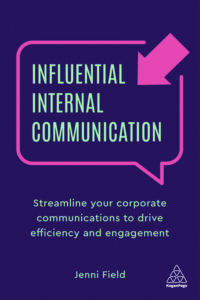 Jenni Field’s Influential Internal Communication: Streamline your corporate communication to drive efficiency and engagement is an excellent read for anyone looking to change their organization for the better. Field discusses internal communication beyond the stereotypical role of editing and document creation and reveals the power of internal communication as a strategic tool.
Jenni Field’s Influential Internal Communication: Streamline your corporate communication to drive efficiency and engagement is an excellent read for anyone looking to change their organization for the better. Field discusses internal communication beyond the stereotypical role of editing and document creation and reveals the power of internal communication as a strategic tool.
The book begins with a general explanation of internal communication and its function in an organization. The author introduces the idea, “Chaos will always exist inside organizations because they are complex” (p. 50), but communication can help manage chaos and support companies on the road to success. The book also discusses the importance of leadership roles in organizations and the value of understanding people. According to Fields, leaders should focus their attention on guiding their teams and enforcing accountability rather than simply implementing changes.
Influential Internal Communication offers The Field Model, the author’s three-step process for evaluating and resolving company issues, as a guide for readers to begin harnessing the power of communications to subdue chaos. The book reviews in detail each step of The Field Model: understand, diagnose, and fix. Field suggests that before an organization can begin to change, it is important to “understand the symptoms, diagnose the cause of those symptoms and create a fix to address them” (p. 128).
The Field Model is useful for all organizations, but practitioners will need to tailor each step to accommodate the specific need of their teams. Field outlines numerous tools for understanding, diagnosing symptoms, and assigning fixes. Included in the text are suggestions such as listening interviews, focus groups, and surveys for assessing problems. Field also offers charts “that outline the chaos, the suggested diagnostic tool and the themes to look out for” (p. 182). The book provides readers with the information they need to begin crafting strategic plans for their organizations.
Whether you’re a company leader, a current communicator, or an employee looking to better define communication in your organization, Field’s Influential Internal Communication is an excellent starting point. No matter the size of your organization, this book explores common problems that can be solved with good communication. Field shares practical guidelines and best practices for communicators to influence culture and backs recommendations with research findings. As readers apply The Field Model and suggested tools to their own work-environment, bold section headers and end-chapter summaries make this book useful as a quick reference guide. Influential Internal Communication is a must-read for anyone who works in an organization and is looking for tools to drive change.
Kalyn Jones
Kalyn Jones is a communication analyst in the automotive industry. She is pursuing a graduate certificate in technical communication from the University of Alabama in Huntsville.

